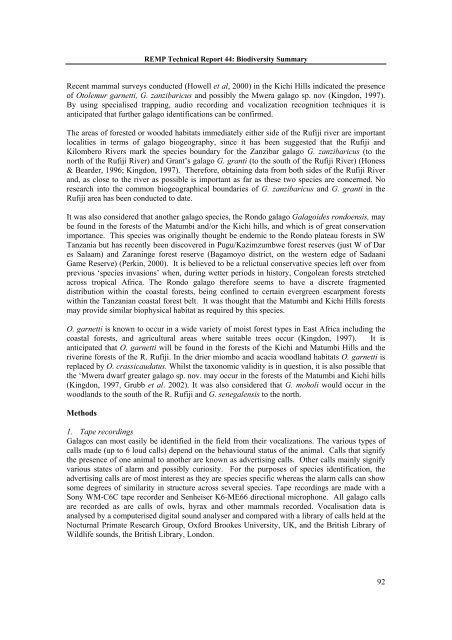Family / Scientific name - Coastal Forests of Kenya and Tanzania
Family / Scientific name - Coastal Forests of Kenya and Tanzania
Family / Scientific name - Coastal Forests of Kenya and Tanzania
Create successful ePaper yourself
Turn your PDF publications into a flip-book with our unique Google optimized e-Paper software.
REMP Technical Report 44: Biodiversity Summary<br />
Recent mammal surveys conducted (Howell et al, 2000) in the Kichi Hills indicated the presence<br />
<strong>of</strong> Otolemur garnetti, G. zanzibaricus <strong>and</strong> possibly the Mwera galago sp. nov (Kingdon, 1997).<br />
By using specialised trapping, audio recording <strong>and</strong> vocalization recognition techniques it is<br />
anticipated that further galago identifications can be confirmed.<br />
The areas <strong>of</strong> forested or wooded habitats immediately either side <strong>of</strong> the Rufiji river are important<br />
localities in terms <strong>of</strong> galago biogeography, since it has been suggested that the Rufiji <strong>and</strong><br />
Kilombero Rivers mark the species boundary for the Zanzibar galago G. zanzibaricus (to the<br />
north <strong>of</strong> the Rufiji River) <strong>and</strong> Grant’s galago G. granti (to the south <strong>of</strong> the Rufiji River) (Honess<br />
& Bearder, 1996; Kingdon, 1997). Therefore, obtaining data from both sides <strong>of</strong> the Rufiji River<br />
<strong>and</strong>, as close to the river as possible is important as far as these two species are concerned. No<br />
research into the common biogeographical boundaries <strong>of</strong> G. zanzibaricus <strong>and</strong> G. granti in the<br />
Rufiji area has been conducted to date.<br />
It was also considered that another galago species, the Rondo galago Galagoides rondoensis, may<br />
be found in the forests <strong>of</strong> the Matumbi <strong>and</strong>/or the Kichi hills, <strong>and</strong> which is <strong>of</strong> great conservation<br />
importance. This species was originally thought be endemic to the Rondo plateau forests in SW<br />
<strong>Tanzania</strong> but has recently been discovered in Pugu/Kazimzumbwe forest reserves (just W <strong>of</strong> Dar<br />
es Salaam) <strong>and</strong> Zaraninge forest reserve (Bagamoyo district, on the western edge <strong>of</strong> Sadaani<br />
Game Reserve) (Perkin, 2000). It is believed to be a relictual conservative species left over from<br />
previous ‘species invasions’ when, during wetter periods in history, Congolean forests stretched<br />
across tropical Africa. The Rondo galago therefore seems to have a discrete fragmented<br />
distribution within the coastal forests, being confined to certain evergreen escarpment forests<br />
within the <strong>Tanzania</strong>n coastal forest belt. It was thought that the Matumbi <strong>and</strong> Kichi Hills forests<br />
may provide similar biophysical habitat as required by this species.<br />
O. garnetti is known to occur in a wide variety <strong>of</strong> moist forest types in East Africa including the<br />
coastal forests, <strong>and</strong> agricultural areas where suitable trees occur (Kingdon, 1997). It is<br />
anticipated that O. garnetti will be found in the forests <strong>of</strong> the Kichi <strong>and</strong> Matumbi Hills <strong>and</strong> the<br />
riverine forests <strong>of</strong> the R. Rufiji. In the drier miombo <strong>and</strong> acacia woodl<strong>and</strong> habitats O. garnetti is<br />
replaced by O. crassicaudatus. Whilst the taxonomic validity is in question, it is also possible that<br />
the ‘Mwera dwarf greater galago sp. nov. may occur in the forests <strong>of</strong> the Matumbi <strong>and</strong> Kichi hills<br />
(Kingdon, 1997, Grubb et al. 2002). It was also considered that G. moholi would occur in the<br />
woodl<strong>and</strong>s to the south <strong>of</strong> the R. Rufiji <strong>and</strong> G. senegalensis to the north.<br />
Methods<br />
1. Tape recordings<br />
Galagos can most easily be identified in the field from their vocalizations. The various types <strong>of</strong><br />
calls made (up to 6 loud calls) depend on the behavioural status <strong>of</strong> the animal. Calls that signify<br />
the presence <strong>of</strong> one animal to another are known as advertising calls. Other calls mainly signify<br />
various states <strong>of</strong> alarm <strong>and</strong> possibly curiosity. For the purposes <strong>of</strong> species identification, the<br />
advertising calls are <strong>of</strong> most interest as they are species specific whereas the alarm calls can show<br />
some degrees <strong>of</strong> similarity in structure across several species. Tape recordings are made with a<br />
Sony WM-C6C tape recorder <strong>and</strong> Senheiser K6-ME66 directional microphone. All galago calls<br />
are recorded as are calls <strong>of</strong> owls, hyrax <strong>and</strong> other mammals recorded. Vocalisation data is<br />
analysed by a computerised digital sound analyser <strong>and</strong> compared with a library <strong>of</strong> calls held at the<br />
Nocturnal Primate Research Group, Oxford Brookes University, UK, <strong>and</strong> the British Library <strong>of</strong><br />
Wildlife sounds, the British Library, London.<br />
92

















